Investigation of Applicability of Impact Factors to Estimate Solar Irradiance: Comparative Analysis Using Machine Learning Algorithms
Abstract
:1. Introduction
- Collecting hourly nine year local weather data and solar irradiance values
- Estimation of one year solar irradiance using the data with the four different methods: linear regression, SVM, MLNN and LSTM
- Analysis of impact factors of each weather parameter
- Comparison of the results and validation of the four estimation methods
2. Methodology
2.1. Linear Regression
2.2. Support Vector Machines
2.3. Artificial Neural Networks (ANNs)
2.3.1. Multi-Layer Neural Network (MLNN)
2.3.2. Recurrent Neural Network
2.4. Meteorogical Data Collection
2.5. Training and Estimation
3. Illustrative Simulation and Analysis
4. Discussions
5. Conclusions
Author Contributions
Funding
Institutional Review Board Statement
Informed Consent Statement
Data Availability Statement
Acknowledgments
Conflicts of Interest
References
- Kirov, B.; Asenovski, S.; Georgieva, K.; Obridko, V.N.; Maris-Muntean, G. Forecasting the sunspot maximum through an analysis of geomagnetic activity. J. Atmos. Sol.-Terr. Phy. 2018, 176, 42–50. [Google Scholar] [CrossRef]
- Ren21. Renewables 2018 Global Status Report. Available online: http://www.ren21.net/gsr-2018/ (accessed on 1 September 2021).
- China, N.E.A.I. National Energy Administration in China; 2015 the state Council of RPC, Beijing, China. Available online: http://english.www.gov.cn/ (accessed on 1 September 2021).
- Kim, K.M.; Cha, J.; Lee, E.; Pham, H.V.; Lee, S.; Theera-Umpon, N. Simplified Neural Network Model Design with Sensitivity Analysis and Electricity Consumption Prediction in a Commercial Building. Energies 2019, 12, 1201. [Google Scholar] [CrossRef] [Green Version]
- Pacheco-Torres, R.; Heo, Y.; Choudhary, R. Efficient energy modelling of heterogeneous building portfolios. Sustain. Cities Soc. 2016, 27, 49–64. [Google Scholar] [CrossRef]
- Chemisana, D.; López-Villada, J.; Coronas, A.; Rosell, J.I.; Lodi, C. Building integration of concentrating systems for solar cooling applications. Appl. Eng. 2013, 50, 1472–1479. [Google Scholar] [CrossRef]
- Lee, H.S. Thermal Design: Heat Sinks, Thermoelectrics, Heat Pipes, Compact Heat Exchangers, ands Solar Cells; Wiley: Hoboken, NJ, USA, 2010. [Google Scholar]
- Qing, X.; Niu, Y. Hourly day-ahead solar irradiance prediction using weather forecasts by LSTM. Energy 2018, 148, 461–468. [Google Scholar] [CrossRef]
- Nixon, J.D.; Dey, P.K.; Davies, P.A. Design of a novel solar thermal collector using a multi-criteria decision-making methodology. J. Clean Prod. 2013, 59, 150–159. [Google Scholar] [CrossRef] [Green Version]
- Torres, J.F.; Troncoso, A.; Koprinska, I.; Wang, Z.; Martínez-Álvarez, F. Big data solar power forecasting based on deep learning and multiple data sources. Expert Syst. 2019, 36, e12394. [Google Scholar] [CrossRef]
- Wei, C.-C. Evaluation of Photovoltaic Power Generation by Using Deep Learning in Solar Panels Installed in Buildings. Energies 2019, 12, 3564. [Google Scholar] [CrossRef] [Green Version]
- Kamadinata, J.O.; Ken, T.L.; Suwa, T. Sky image-based solar irradiance prediction methodologies using artificial neural networks. Renew. Energy 2019, 134, 837–845. [Google Scholar] [CrossRef]
- Ahmad, A.; Anderson, T.N.; Lie, T.T. Hourly global solar irradiation forecasting for New Zealand. Sol. Energy 2015, 122, 1398–1408. [Google Scholar] [CrossRef] [Green Version]
- Watanabe, T.; Nohara, D. Prediction of time series for several hours of surface solar irradiance using one-granule cloud property data from satellite observations. Sol. Energy 2019, 186, 113–125. [Google Scholar] [CrossRef]
- Çelik, Ö.; Teke, A.; Yıldırım, H.B. The optimized artificial neural network model with Levenberg–Marquardt algorithm for global solar radiation estimation in Eastern Mediterranean Region of Turkey. J. Clean Prod. 2016, 116, 1–12. [Google Scholar] [CrossRef]
- Wang, L.; Shi, J. A Comprehensive Application of Machine Learning Techniques for Short-Term Solar Radiation Prediction. Appl. Sci. 2021, 11, 5808. [Google Scholar] [CrossRef]
- Herrera, V.M.V.; Soon, W.; Legates, D.R. Does Machine Learning reconstruct missing sunspots and forecast a new solar minimum? Adv. Space Res. 2021, 68, 1485–1501. [Google Scholar] [CrossRef]
- Ruiz-Arias, J.A.; Gueymard, C.A.; Santos-Alamillos, F.J.; Quesada-Ruiz, S.; Pozo-Vázquez, D. Bias induced by the AOD representation time scale in long-term solar radiation calculations. Part 2: Impact on long-term solar irradiance predictions. Sol. Energy 2016, 135, 625–632. [Google Scholar] [CrossRef]
- Ruiz-Arias, J.A.; Gueymard, C.A.; Santos-Alamillos, F.J.; Pozo-Vázquez, D. Worldwide impact of aerosol’s time scale on the predicted long-term concentrating solar power potential. Sci. Rep. 2016, 6, 30546. [Google Scholar] [CrossRef] [Green Version]
- Malik, H.; Garg, S. Long-Term Solar Irradiance Forecast Using Artificial Neural Network: Application for Performance Prediction of Indian Cities. In Applications of Artificial Intelligence Techniques in Engineering; Springer: Singapore, 2019; pp. 285–293. [Google Scholar]
- Cao, J.C.; Cao, S.H. Study of forecasting solar irradiance using neural networks with preprocessing sample data by wavelet analysis. Energy 2006, 31, 3435–3445. [Google Scholar] [CrossRef]
- Voyant, C.; Muselli, M.; Paoli, C.; Nivet, M.-L. Numerical weather prediction (NWP) and hybrid ARMA/ANN model to predict global radiation. Energy 2012, 39, 341–355. [Google Scholar] [CrossRef] [Green Version]
- MP Garniwa, P.; AA Ramadhan, R.; Lee, H.-J. Application of Semi-Empirical Models Based on Satellite Images for Estimating Solar Irradiance in Korea. Appl. Sci. 2021, 11, 3445. [Google Scholar] [CrossRef]
- Cheng, H.-Y.; Yu, C.-C. Multi-model solar irradiance prediction based on automatic cloud classification. Energy 2015, 91, 579–587. [Google Scholar] [CrossRef]
- Sharma, V.; Yang, D.; Walsh, W.; Reindl, T. Short term solar irradiance forecasting using a mixed wavelet neural network. Renew. Energy 2016, 90, 481–492. [Google Scholar] [CrossRef]
- Dong, Z.; Yang, D.; Reindl, T.; Walsh, W.M. Satellite image analysis and a hybrid ESSS/ANN model to forecast solar irradiance in the tropics. Energy Convers. Manag. 2014, 79, 66–73. [Google Scholar] [CrossRef]
- Mellit, A.; Eleuch, H.; Benghanem, M.; Elaoun, C.; Pavan, A.M. An adaptive model for predicting of global, direct and diffuse hourly solar irradiance. Energy Convers. Manag. 2010, 51, 771–782. [Google Scholar] [CrossRef]
- Paulescu, M.; Paulescu, E. Short-term forecasting of solar irradiance. Renew. Energy 2019, 143, 985–994. [Google Scholar] [CrossRef]
- Sun, F.; Gramacy, R.B.; Haaland, B.; Lu, S.; Hwang, Y. Synthesizing simulation and field data of solar irradiance. Stat. Anal. Data Min. ASA Data Sci. J. 2019, 12, 311–324. [Google Scholar] [CrossRef] [Green Version]
- Hou, M.; Zhang, T.; Weng, F.; Ali, M.; Al-Ansari, N.; Yaseen, M.Z. Global Solar Radiation Prediction Using Hybrid Online Sequential Extreme Learning Machine Model. Energies 2018, 11, 3415. [Google Scholar] [CrossRef] [Green Version]
- Chang, J.F.; Dong, N.; Ip, W.H.; Yung, K.L. An ensemble learning model based on Bayesian model combination for solar energy prediction. J. Renew. Sustain. Energy 2019, 11, 043702. [Google Scholar] [CrossRef]
- Joshi, B.; Kay, M.; Copper, J.K.; Sproul, A.B. Evaluation of solar irradiance forecasting skills of the Australian Bureau of Meteorology’s ACCESS models. Sol. Energy 2019, 188, 386–402. [Google Scholar] [CrossRef]
- Ruiz-Arias, J.A.; Gueymard, C.A. A multi-model benchmarking of direct and global clear-sky solar irradiance predictions at arid sites using a reference physical radiative transfer model. Sol. Energy 2018, 171, 447–465. [Google Scholar] [CrossRef]
- Murata, A.; Ohtake, H.; Oozeki, T. Modeling of uncertainty of solar irradiance forecasts on numerical weather predictions with the estimation of multiple confidence intervals. Renew. energy 2018, 117, 193–201. [Google Scholar] [CrossRef]
- Miller, S.D.; Rogers, M.A.; Haynes, J.M.; Sengupta, M.; Heidinger, A.K. Short-term solar irradiance forecasting via satellite/model coupling. Sol. Energy 2018, 168, 102–117. [Google Scholar] [CrossRef]
- Ong, R.H.; King, A.J.C.; Caley, M.J.; Mullins, B.J. Prediction of solar irradiance using ray-tracing techniques for coral macro- and micro-habitats. Mar. Environ. Res. 2018, 141, 75–87. [Google Scholar] [CrossRef]
- Aggarwal, S.K.; Saini, L.M. Solar energy prediction using linear and non-linear regularization models: A study on AMS (American Meteorological Society) 2013–14 Solar Energy Prediction Contest. Energy 2014, 78, 247–256. [Google Scholar] [CrossRef]
- Svozil, D.; Kvasnicka, V.; Pospichal, J. Introduction to multi-layer feed-forward neural networks. Chemom. Intell. Lab. Syst. 1997, 39, 43–62. [Google Scholar] [CrossRef]
- Tetlow, R.M.; van Dronkelaar, C.; Beaman, C.P.; Elmualim, A.A.; Couling, K. Identifying behavioural predictors of small power electricity consumption in office buildings. Build Environ. 2015, 92, 75–85. [Google Scholar] [CrossRef]
- Ye, Z.; Kim, M.K. Predicting electricity consumption in a building using an optimized back-propagation and Levenberg–Marquardt back-propagation neural network: Case study of a shopping mall in China. Sustain. Cities Soc. 2018, 42, 176–183. [Google Scholar] [CrossRef]
- Zhu, Y.; Kim, M.K.; Wen, H. Simulation and Analysis of Perturbation and Observation-Based Self-Adaptable Step Size Maximum Power Point Tracking Strategy with Low Power Loss for Photovoltaics. Energies 2018, 12, 92. [Google Scholar] [CrossRef] [Green Version]
- Administration, K.M. Weather data, Korea Metrological Administration. Available online: www.kma.go.kr (accessed on 1 September 2019).
- Pino-Mejías, R.; Pérez-Fargallo, A.; Rubio-Bellido, C.; Pulido-Arcas, J.A. Artificial neural networks and linear regression prediction models for social housing allocation: Fuel Poverty Potential Risk Index. Energy 2018, 164, 627–641. [Google Scholar] [CrossRef]
- Yan, X.; Su, X.G. Linear Regression Analysis: Theory and Computing; World Sceintific: Singarpore, Singarpore, 2009. [Google Scholar] [CrossRef]
- Zhong, H.; Wang, J.; Jia, H.; Mu, Y.; Lv, S. Vector field-based support vector regression for building energy consumption prediction. Appl. Energy 2019, 242, 403–414. [Google Scholar] [CrossRef]
- Meenal, R.; Selvakumar, A.I. Assessment of SVM, empirical and ANN based solar radiation prediction models with most influencing input parameters. Renew. Energy 2018, 121, 324–343. [Google Scholar] [CrossRef]
- Duan, H.; Huang, Y.; Mehra, R.K.; Song, P.; Ma, F. Study on influencing factors of prediction accuracy of support vector machine (SVM) model for NOx emission of a hydrogen enriched compressed natural gas engine. Fuel 2018, 234, 954–964. [Google Scholar] [CrossRef]
- Buhmann, M.D. Radial Basis Functions [Electronic Resource]: Theory and Implementations; Cambridge University Press: Cambridge, UK, 2003. [Google Scholar]
- LeCun, Y.; Bengio, Y.; Hinton, G. Deep learning. Nature 2015, 521, 436–444. [Google Scholar] [CrossRef] [PubMed]
- Hornik, K.; Stinchcombe, M.; White, H. Multilayer Feedforward Networks Are Universal Approximators. Neural. Netw. 1989, 2, 359–366. [Google Scholar] [CrossRef]
- White, H. Connectionist Nonparametric Regression—Multilayer Feedforward Networks Can Learn Arbitrary Mappings. Neural. Netw. 1990, 3, 535–549. [Google Scholar] [CrossRef]
- Krizhevsky, A.; Sutskever, I.; Hinton, G.E. ImageNet Classification with Deep Convolutional Neural Networks. Commun. ACM 2017, 60, 84–90. [Google Scholar] [CrossRef]
- Graves, A.; Mohamed, A.R.; Hinton, G. Speech Recognition with Deep Recurrent Neural Networks. In Proceedings of the 2013 IEEE International Conference on Acoustics, Speech and Signal Processing, Vancouver, BC, Canada, 26–31 May 2013. [Google Scholar]
- Kingma, D.P.; Welling, M. Auto-Encoding Variational Bayes. arXiv 2013, arXiv:1312.6114. [Google Scholar]
- Xian, Y.; Schiele, B.; Akata, Z. Zero-Shot Learning—The Good, the Bad and the Ugly. In Proceedings of the IEEE Conference on Computer Vision and Pattern Recognition, Honolulu, HI, USA, 22–25 July 2017. [Google Scholar]
- Radford, A.; Metz, L.; Chintala, S. Unsupervised Representation Learning with Deep Convolutional Generative Adversarial Networks. arXiv 2015, arXiv:1511.06434. [Google Scholar]
- Ban, J.-C.; Chang, C.-H. The learning problem of multi-layer neural networks. Neural. Netw. 2013, 46, 116–123. [Google Scholar] [CrossRef] [PubMed]
- Kamimura, R. SOM-based information maximization to improve and interpret multi-layered neural networks: From information reduction to information augmentation approach to create new information. Expert. Syst. Appl. 2019, 125, 397–411. [Google Scholar] [CrossRef]
- Greff, K.; Srivastava, R.K.; Koutník, J.; Steunebrink, B.R.; Schmidhuber, J. LSTM: A Search Space Odyssey. arXiv 2015, arXiv:1503.04069. [Google Scholar] [CrossRef] [Green Version]
- Yang, B.; Sun, S.; Li, J.; Lin, X.; Tian, Y. Traffic flow prediction using LSTM with feature enhancement. Neurocomputing 2019, 332, 320–327. [Google Scholar] [CrossRef]
- Baek, Y.; Kim, H.Y. ModAugNet: A new forecasting framework for stock market index value with an overfitting prevention LSTM module and a prediction LSTM module. Expert. Syst. Appl. 2018, 113, 457–480. [Google Scholar] [CrossRef]
- Göçken, M.; Özçalıcı, M.; Boru, A.; Dosdoğru, A.T. Integrating metaheuristics and Artificial Neural Networks for improved stock price prediction. Expert. Syst. Appl. 2016, 44, 320–331. [Google Scholar] [CrossRef]
- Yuan, X.; Chen, C.; Jiang, M.; Yuan, Y. Prediction interval of wind power using parameter optimized Beta distribution based LSTM model. Appl. Soft Comput. 2019, 82, 105550. [Google Scholar] [CrossRef]
- ASHRAE. ASHRAE Guideline 14–2002: Measurement of Energy and Demand Savings; ASHRAE: Atlanta, GA, USA, 2002. [Google Scholar]
- Amber, K.P.; Aslam, M.W.; Hussain, S.K. Electricity consumption forecasting models for administration buildings of the UK higher education sector. Energy Build 2015, 90, 127–136. [Google Scholar] [CrossRef]
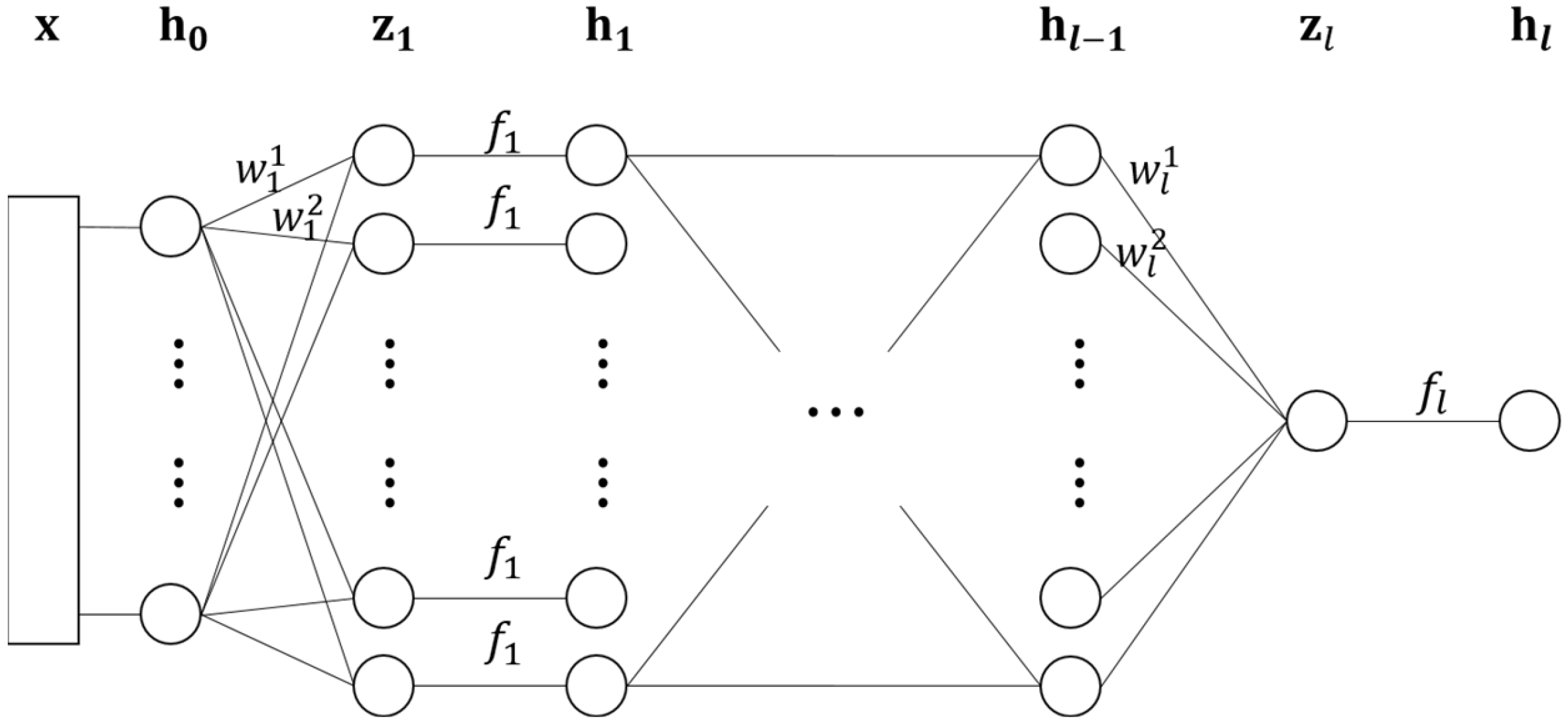
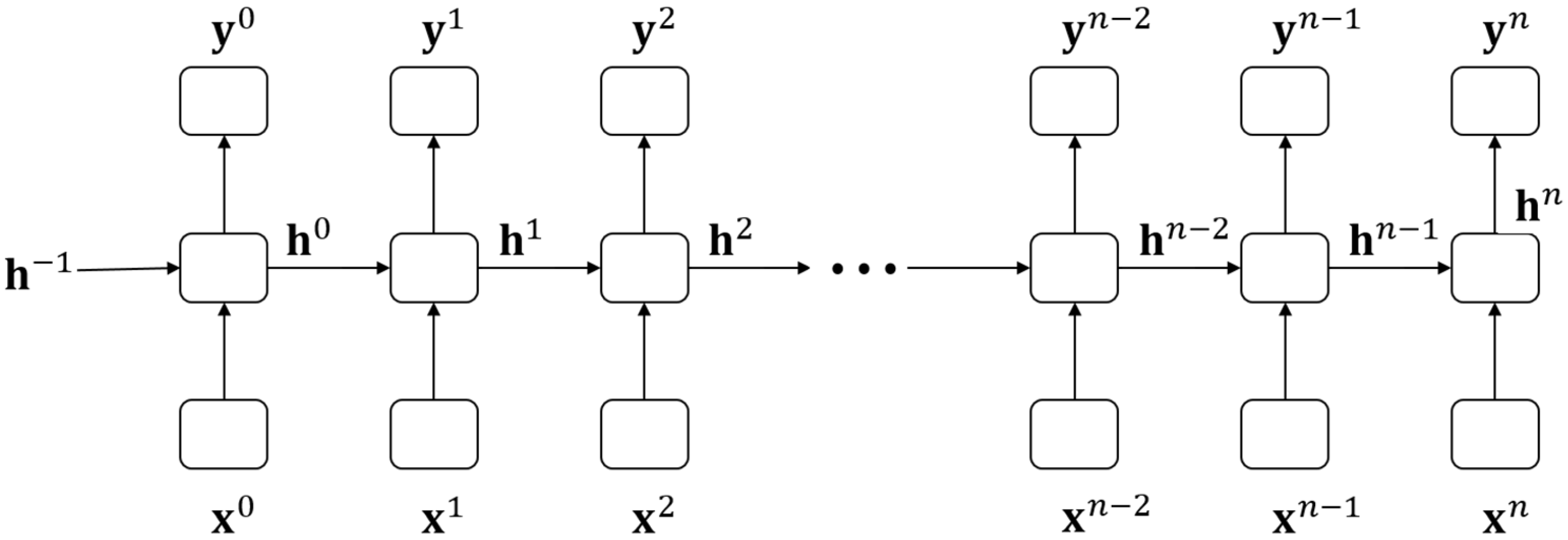
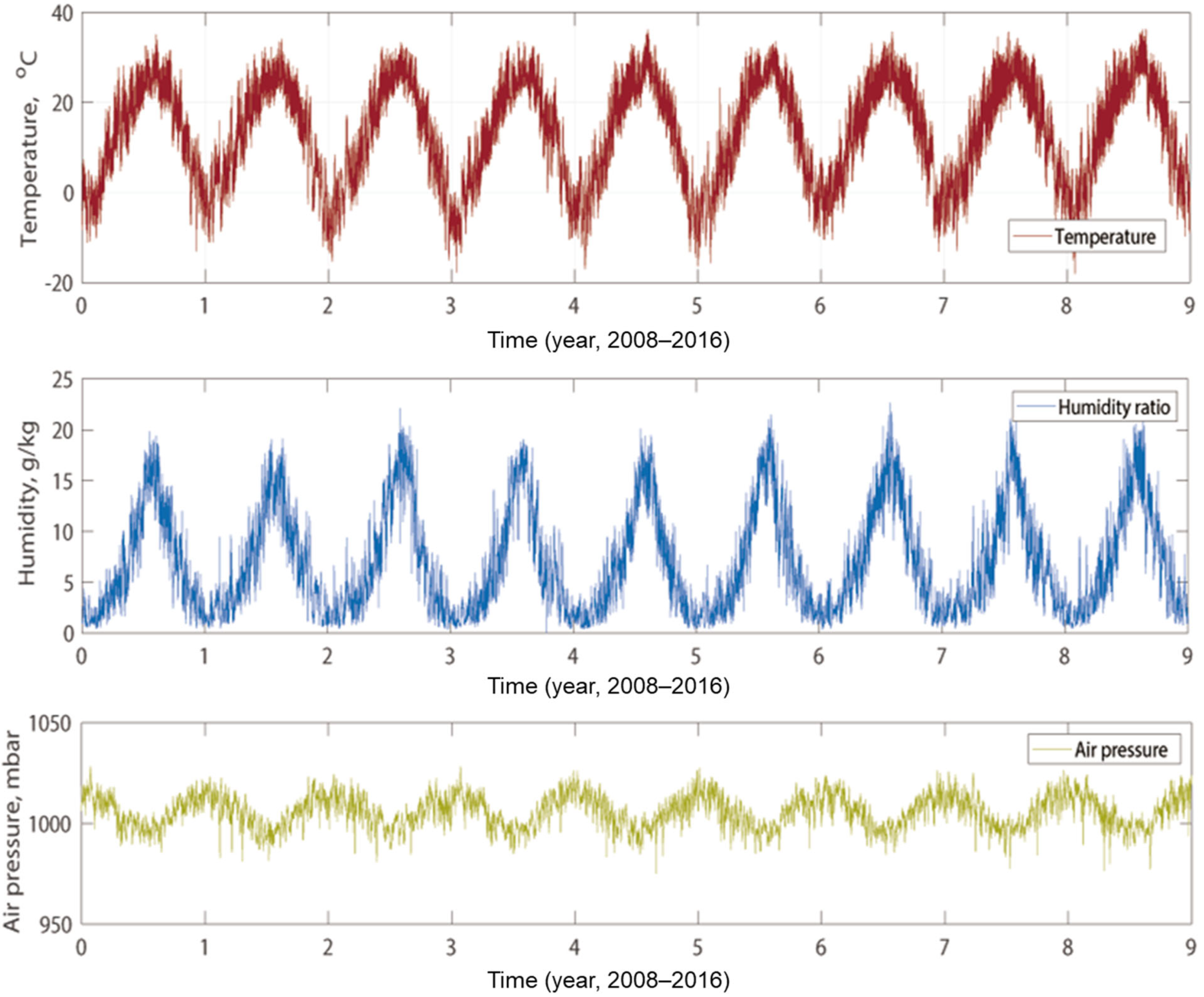
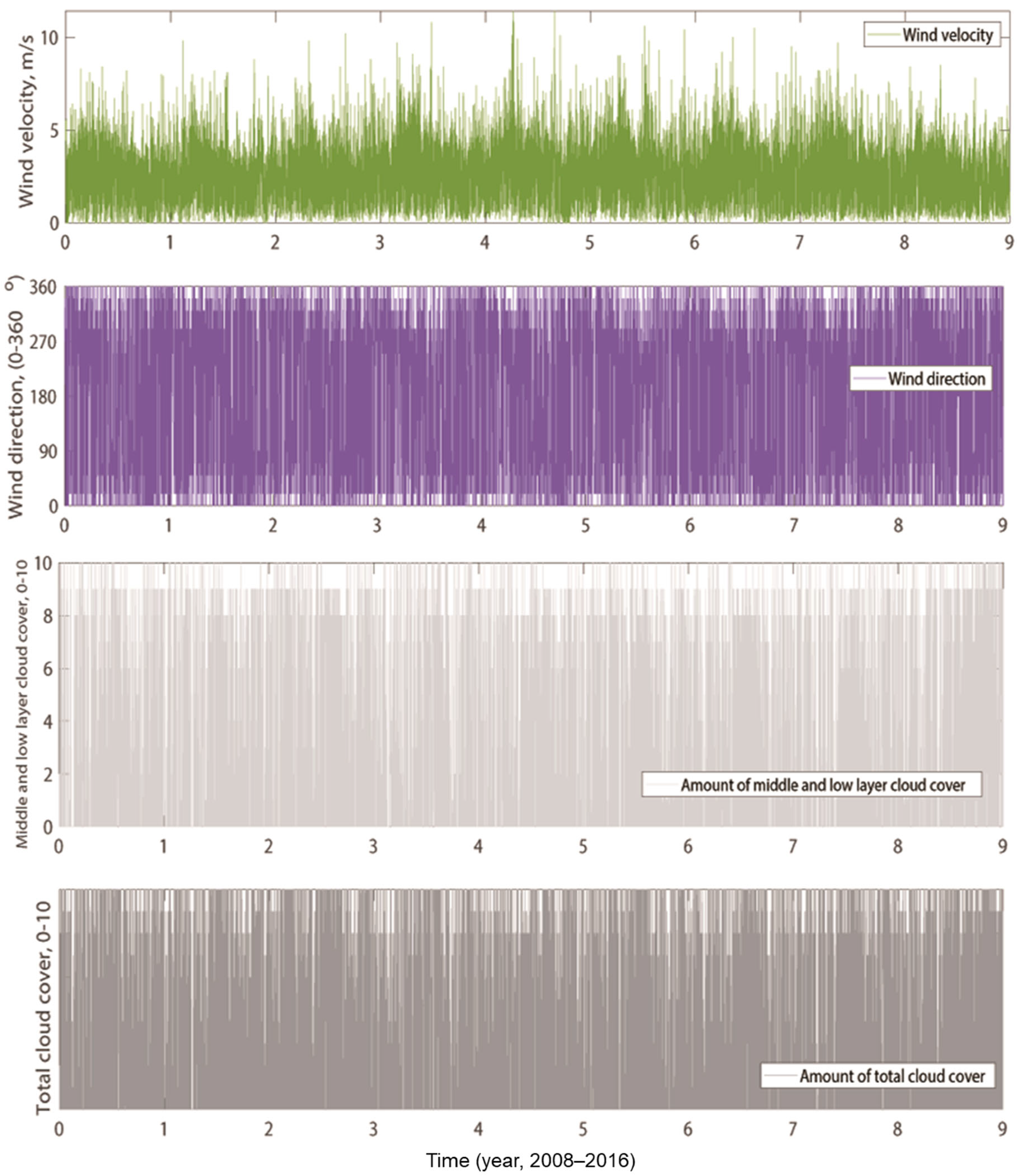

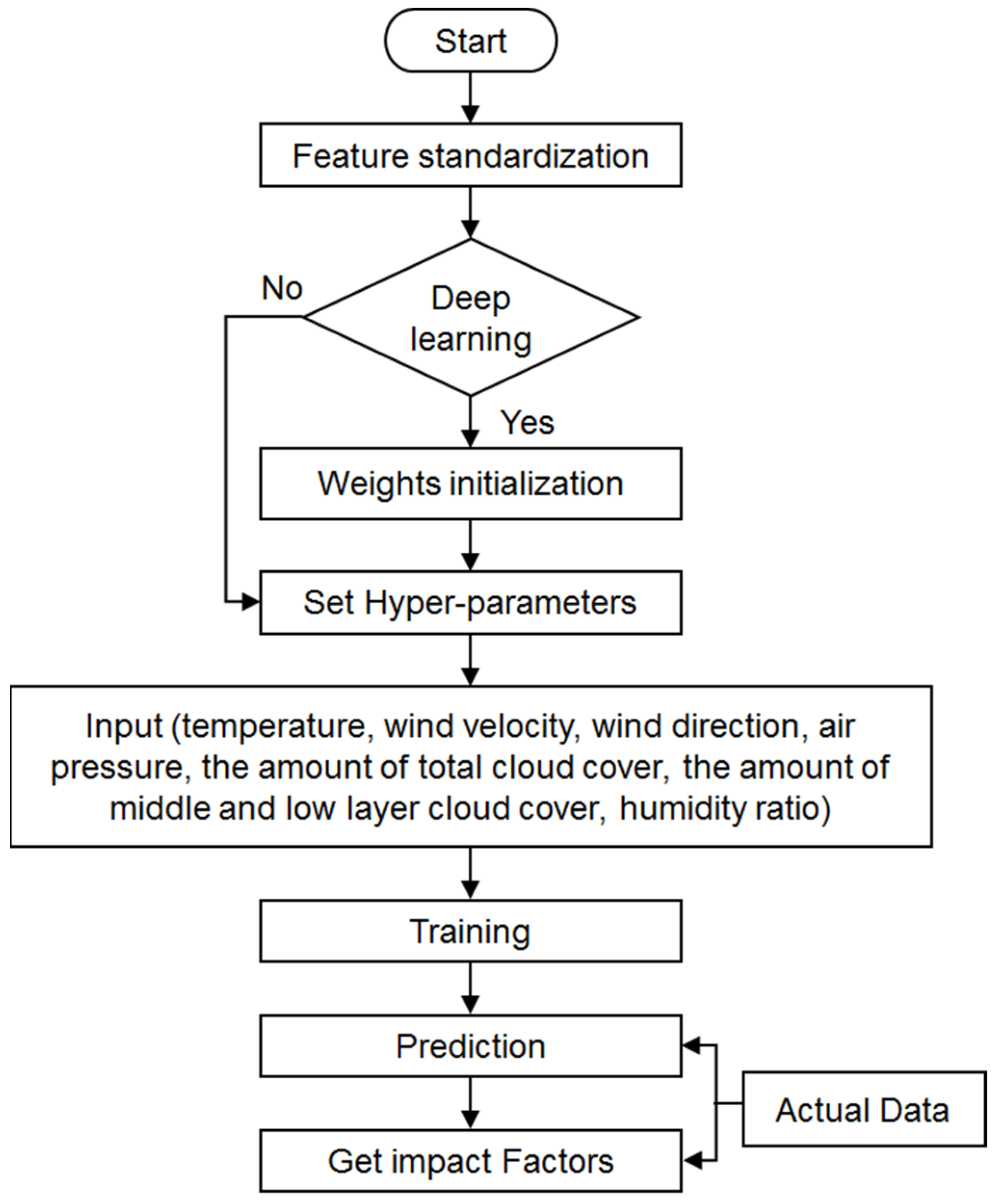
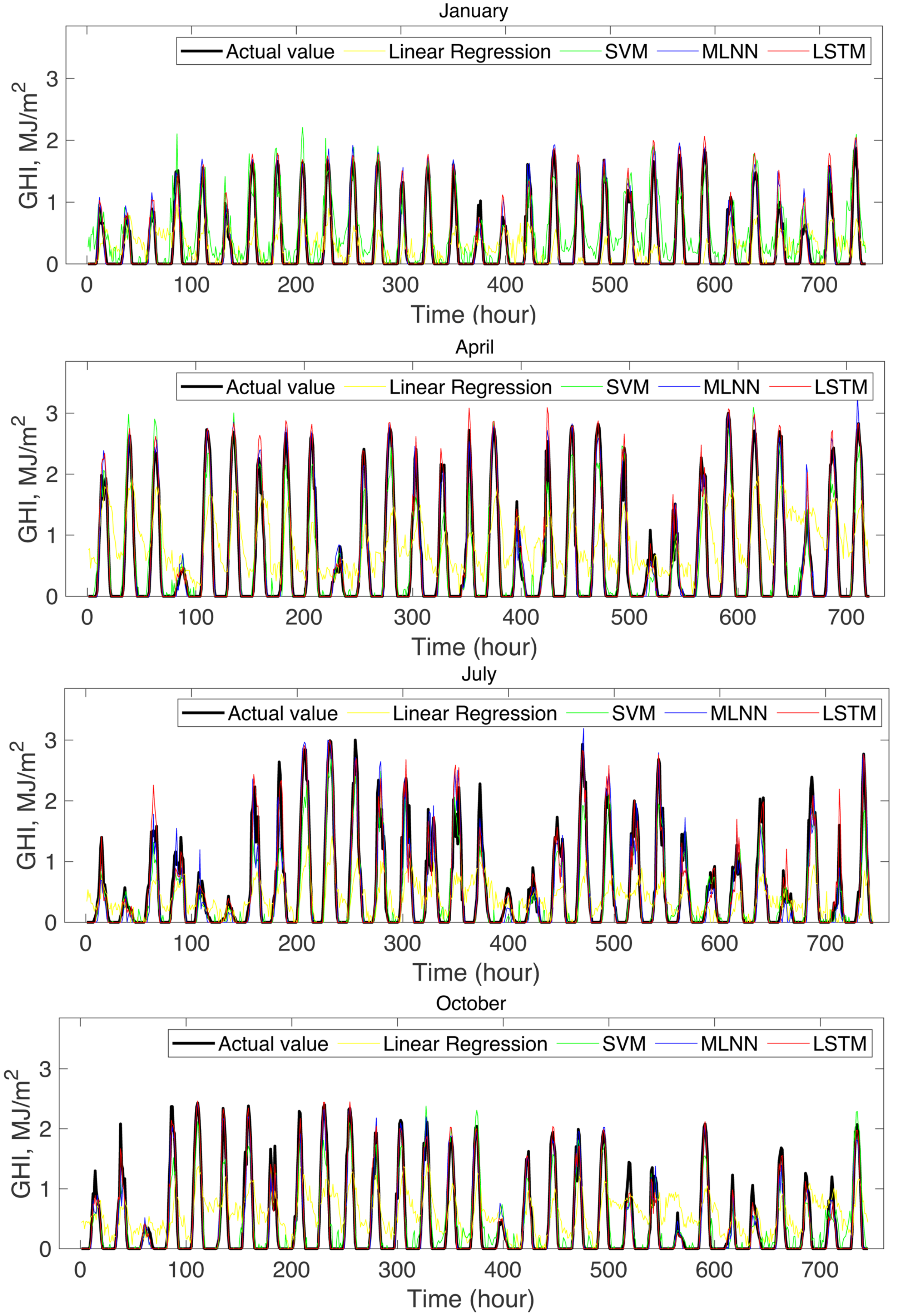
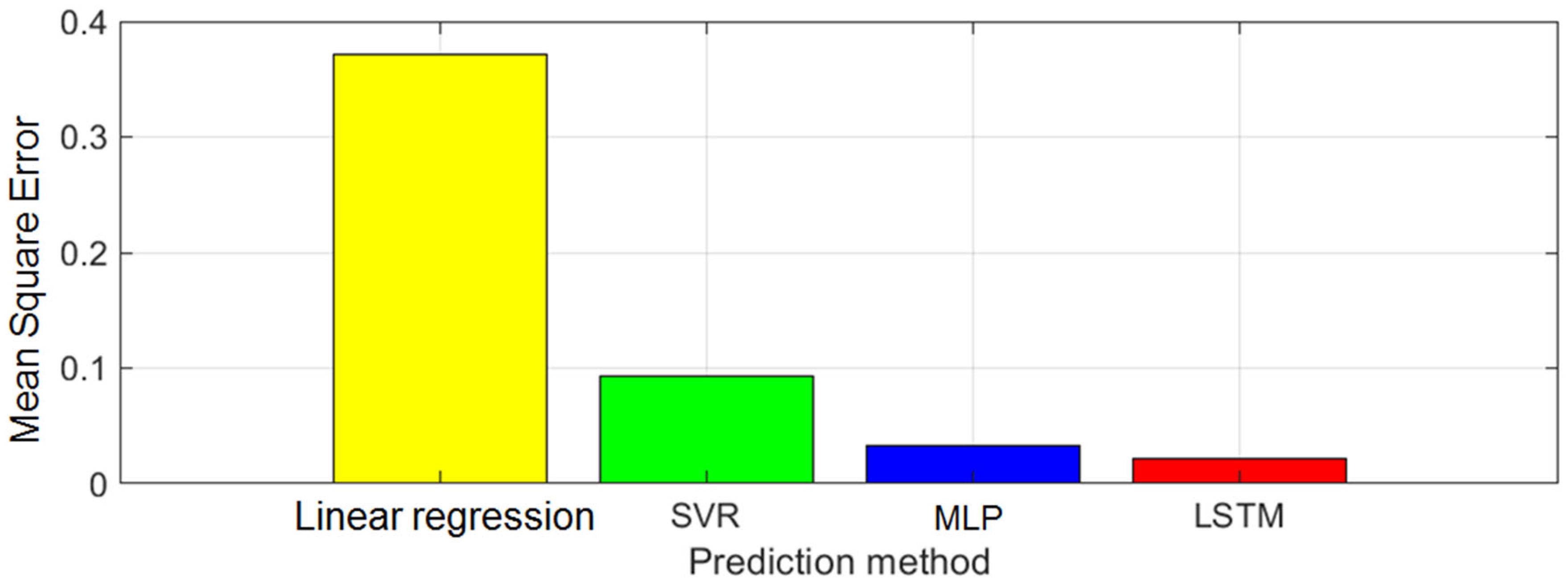

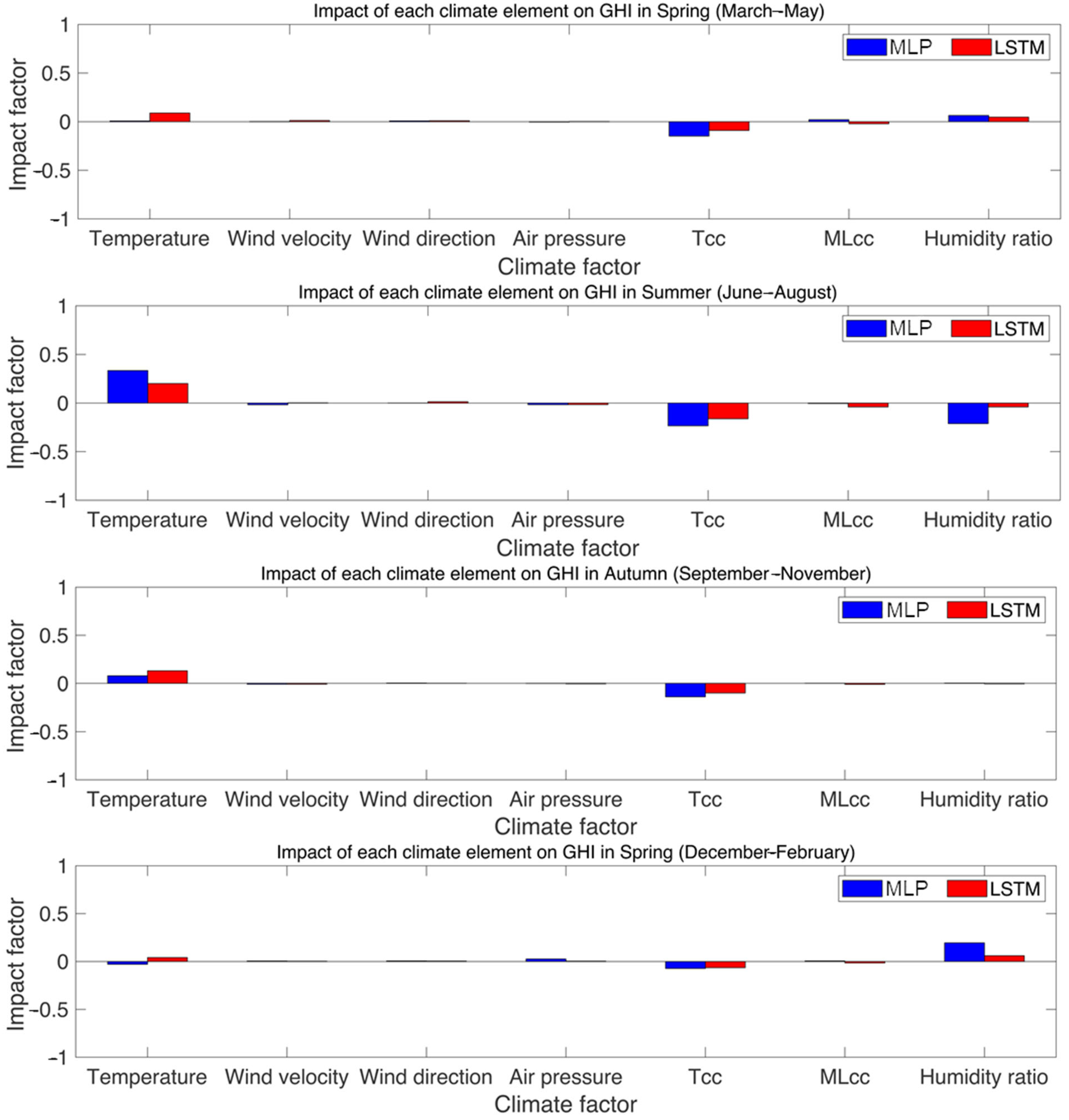
| Impact Factor | Temperature | Wind Speed | Wind Direction | Air Pressure | Tcc | MLcc | Humidity Raito |
|---|---|---|---|---|---|---|---|
| MLNN | |||||||
| Spring | 0.0065 | 0.0010 | 0.007 | −0.003 | −0.14 | 0.02 | 0.064 |
| Summer | 0.33 | −0.017 | 0.00008 | −0.0167 | −0.234 | −0.004 | −0.2116 |
| Fall | 0.078 | −0.0084 | 0.0035 | −0.0006 | −0.1367 | 0.0011 | 0.00222 |
| Winter | −0.029 | 0.0045 | 0.0054 | 0.026 | −0.073 | 0.0059 | 0.1948 |
| LSTM | |||||||
| Spring | 0.08877 | 0.012 | 0.0092 | 0.00128 | −0.090 | −0.0213 | 0.0467 |
| Summer | 0.201 | 0.0023 | 0.0136 | −0.0158 | −0.1622 | −0.0399 | −0.0403 |
| Fall | 0.1303 | −0.0084 | 0.00082 | −0.00432 | −0.097 | −0.00957 | −0.0040 |
| Winter | 0.04 | 0.0023 | 0.0040 | 0.0035 | −0.064 | −0.0149 | 0.0602 |
Publisher’s Note: MDPI stays neutral with regard to jurisdictional claims in published maps and institutional affiliations. |
© 2021 by the authors. Licensee MDPI, Basel, Switzerland. This article is an open access article distributed under the terms and conditions of the Creative Commons Attribution (CC BY) license (https://creativecommons.org/licenses/by/4.0/).
Share and Cite
Cha, J.; Kim, M.K.; Lee, S.; Kim, K.S. Investigation of Applicability of Impact Factors to Estimate Solar Irradiance: Comparative Analysis Using Machine Learning Algorithms. Appl. Sci. 2021, 11, 8533. https://doi.org/10.3390/app11188533
Cha J, Kim MK, Lee S, Kim KS. Investigation of Applicability of Impact Factors to Estimate Solar Irradiance: Comparative Analysis Using Machine Learning Algorithms. Applied Sciences. 2021; 11(18):8533. https://doi.org/10.3390/app11188533
Chicago/Turabian StyleCha, Jaehoon, Moon Keun Kim, Sanghyuk Lee, and Kyeong Soo Kim. 2021. "Investigation of Applicability of Impact Factors to Estimate Solar Irradiance: Comparative Analysis Using Machine Learning Algorithms" Applied Sciences 11, no. 18: 8533. https://doi.org/10.3390/app11188533
APA StyleCha, J., Kim, M. K., Lee, S., & Kim, K. S. (2021). Investigation of Applicability of Impact Factors to Estimate Solar Irradiance: Comparative Analysis Using Machine Learning Algorithms. Applied Sciences, 11(18), 8533. https://doi.org/10.3390/app11188533








